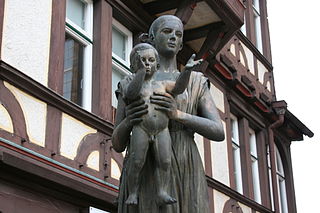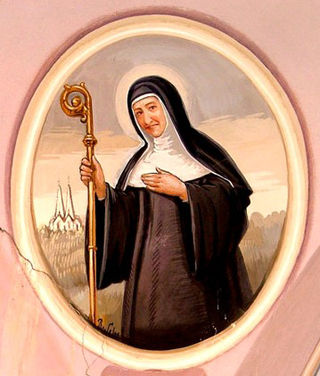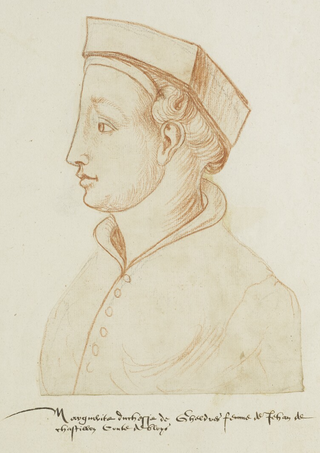See also
- 873 Mechthild, main-belt asteroid
Mechthild is a female Germanic given name. It is an old form of the first name Matilda and means "powerful in combat, powerful fighter".
Variants include Mechthilde, Mechthildis, Mechtild, Mechtilde or Mechtildis.
Year 1481 (MCDLXXXI) was a common year starting on Monday of the Julian calendar).

1602 (MDCII) was a common year starting on Tuesday of the Gregorian calendar and a common year starting on Friday of the Julian calendar, the 1602nd year of the Common Era (CE) and Anno Domini (AD) designations, the 602nd year of the 2nd millennium, the 2nd year of the 17th century, and the 3rd year of the 1600s decade. As of the start of 1602, the Gregorian calendar was 10 days ahead of the Julian calendar, which remained in localized use until 1923.

.

Year 1160 (MCLX) was a leap year starting on Friday of the Julian calendar.

Henry I of Hesse "the Child" was the first Landgrave of Hesse. He was the son of Henry II, Duke of Brabant and Sophie of Thuringia.

Peter August Friedrich, Duke of Schleswig-Holstein-Sonderburg-Beck was a Duke of Schleswig-Holstein-Sonderburg-Beck.

Mechtilde of Hackeborn, OSB, also known as Mechtilde of Helfta, was a Saxon Christian saint and a Benedictine nun. She was famous for her musical talents, gifted with a beautiful voice. At the age of 50, Mechtilde went through a grave spiritual crisis, as well as physical suffering. In the modern Benedictine calendar, her feast is celebrated on the anniversary of her death, November 19. She died in the convent of Helfta, near Eisleben.
The House of Sponheim or Spanheim was a medieval German noble family, which originated in Rhenish Franconia. They were immediate Counts of Sponheim until 1437 and Dukes of Carinthia from 1122 until 1269. Its cadet branches ruled in the Imperial County of Ortenburg-Neuortenburg and various Sayn-Wittgenstein states until 1806.

The House of Andechs was a feudal line of German princes in the 12th and 13th centuries. The counts of Dießen-Andechs obtained territories in northern Dalmatia on the Adriatic seacoast, where they became Margraves of Istria and ultimately dukes of a short-lived imperial state named Merania from 1180 to 1248. They were also self-styled lords of Carniola.

Matilda, also spelled Mathilda and Mathilde, is the English form of the Germanic female name Mahthildis, which derives from the Old High German "maht" and "hild".

Gandersheim Abbey is a former house of secular canonesses (Frauenstift) in the present town of Bad Gandersheim in Lower Saxony, Germany. It was founded in 852 by Count Liudolf of Saxony and his wife, Oda, progenitors of the Liudolfing or Ottonian dynasty, whose rich endowments ensured its stability and prosperity.

Herford Abbey was the oldest women's religious house in the Duchy of Saxony. It was founded as a house of secular canonesses in 789, initially in Müdehorst by a nobleman called Waltger, who moved it in about 800 onto the lands of his estate Herivurth which stood at the crossing of a number of important roads and fords over the Aa and the Werre. The present city of Herford grew up on this site around the abbey.

Reginald II of Guelders, called "the Black", was Count of Guelders, and from 1339 onwards Duke of Guelders, and Zutphen, in the Low Countries, from 1326 to 1343. He was the son of Reginald I of Guelders and Marguerite of Flanders.
Agnes of Holstein was a Countess of Holstein-Kiel by birth and by marriage a Duchess of Saxe-Lauenburg. She was the daughter of Count John III of Holstein-Plön and Catherine, daughter of Duke Henry III of Silesia-Glogau.
Margaret of Cleves, also spelled Margaretha or Margarethe was the wife of Count Adolf II of the Marck and mother of Adolf III of the Marck. She was a daughter of Count Dietrich VIII of Cleves and Margaret of Guelders, who was a daughter of Reginald I of Guelders.
Countess Mechthild of Sayn, also called Mechthild of Landsberg, Mechtild, Mechtildis or Mathilde, was the wife of Henry III of Sayn. She was an important figure in the Late Middle Ages because of her religious foundations (Stiftungen).

Mechtild of Guelders was the ruling suo jure Duchess of Guelders from 1371 to 1379, after succeeding her brother, Reginald II, Duke of Guelders.